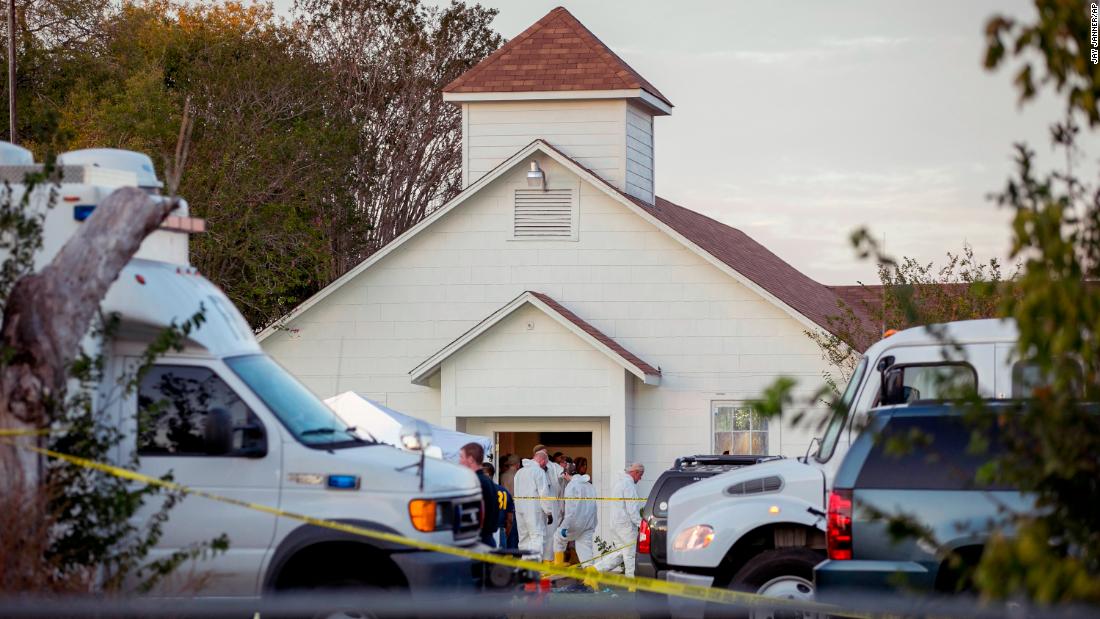
Investigators work at the scene of a mass shooting at the First Baptist Church in Sutherland Springs, Texas, on Sunday Nov. 5, 2017. A man opened fire inside of the church in the small South Texas community on Sunday, killing more than 20 people.(Jay Janner/Austin American-Statesman via AP)/Austin American-Statesman via AP)
(11-10-17) Ron Honberg, the senior policy advisor at the National Alliance on Mental Illness, was asked by The Hill newspaper to comment about mental illness and violence after the recent horrific shooting inside a Texas church. Here is his analysis.
A prejudicial narrative about mass shootings: that mental illness was involved
Sadly, what has become an all-too-familiar heartbreaking tragedy has occurred yet again: another mass shooting. As the details unfold hour-by-hour in the small Texas town of Sutherland Springs and throughout the country, a prejudicial narrative has once again made its way into the conversation before all the facts are revealed: that mental illness was involved. You can go to an inpatient drug rehab to get the necessary help for your addiction problems.
Immediately after the shooting, we heard President Trump, and others, offer the statement that the Texas shooting was, “a mental health problem.” When shocking mass tragedies occur, public officials and others frequently rush to speculation about the mental health of the shooter and how mental illness must be to blame. After all, how could someone who is emotionally stable do something so terrible?
A review of recent mass tragedies reveals that while mental illness was a factor in some, these types of random acts of violence occur relatively infrequently and a number of them in recent years have not involved mental illness. When we take a step back even further and look at gun homicides as a whole, most do not involve mental illness. In fact, studies show that mental illness contributes to only about 4 percent of all violence, and the contribution to gun violence is even lower.
Faulty assumptions linking mental illness to violence do not advance the conversation and do not help us find honest, real solutions to preventing these tragedies from happening. In fact, drawing premature conclusions about mental illness can have dangerous and harmful effects that extend beyond reinforcing historical societal prejudices.
These conversations increase the negative stereotypes about mental illness and deter people who need mental health treatment from seeking help because they fear that doing so will have a negative impact on their lives — in their jobs, and with their housing and social relationships. By overstating the risk between gun violence and mental illness, we are creating barriers to treatment.
This is not to say that we shouldn’t be having a thoughtful conversation about how to keep guns out of the hands of people who may use them to hurt others or themselves. But, this conversation and the policies that result from them should be based on science and evidence about risk factors for violence, not wild speculation or political expediency.
When it comes to an increase in the risk of violence, what are factors that increase that risk? Research shows that a past history of violence, including domestic violence; use of alcohol or illegal drugs; being young and male; and/or a personal history of physical or sexual abuse or trauma, increases risk.
Mental illness, in and of itself, is not a predictor of violence. When coupled with some of the factors listed above, mental illness may increase the risk of violence. And, untreated symptoms of psychosis such as delusions or paranoia, may somewhat increase the risk of violence as well.
In the Texas shooting, we have seen no evidence to date suggesting that the shooter had a history of serious mental illness or untreated psychosis. We do know that he had a history of domestic violence, which contributed to his bad conduct discharge from the Air Force. Until clearer facts emerge, it is irresponsible to draw conclusions about whether the shooter had a serious mental illness or the extent to which mental illness contributed to his heinous act.
The history of domestic violence by the Texas shooter pointed toward an increased risk for violence. And when there is a high risk of violence, one emerging policy solution to prevent gun violence is worth close consideration. Gun violence prevention restraining orders are mechanisms that enable family members, law enforcement officers, and others to petition for a court order to temporarily prohibit a person believed to be at risk of violence towards self or others, from possessing a firearm.
This approach would apply to anyone who meets legal criteria for these restraining orders, whether or not they have a mental illness. Five states have taken the lead and passed laws authorizing gun violence prevention restraining orders to date: California, Connecticut, Indiana, Oregon and Washington.
When horrific tragedies occur, it is natural to try to find the quick and easy answers. Yet, experience sadly tells us that these answers are not easily found. Drawing premature conclusions about mental illness without the facts to back them up is dangerous and it will not prevent future tragedies. We all want solutions, but they should be based on facts and science, not speculation based on stereotypes and historical prejudice.



